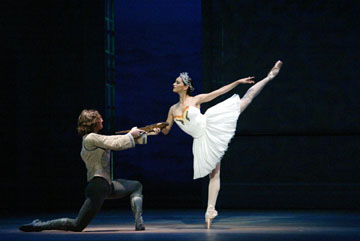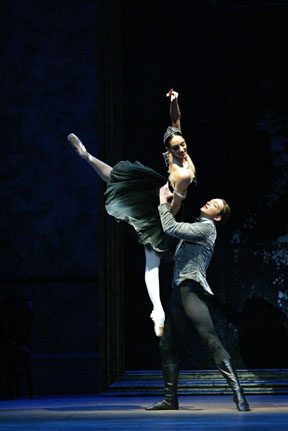Cloudless Skies
Swan Lake
Pennsylvania Ballet
Academy of Music
Philadelphia, Pennsylvania
June 4, June 5 matinee and evening, 2004
by Mary Cargill
copyright
© 2004 by Mary Cargill
published June 8, 2004
 The
myth of the half-human woman, be she part swan, seal or fish, is an ancient
and worldwide story. The earliest version of the swan maiden, it seems,
is the Indian myth, based on the idea of the sky as a sea, and the dawn
clouds as captives, who disappear with the sun. The “soul of the
people” Romanticism of the early nineteenth century encouraged the
collection of folktales from the semi-literate peasantry, and these stories,
slightly polished and cleaned up (the frog-prince was originally x-rated)
entered the artistic and intellectual world. But these stories were not
decorative; they were based firmly on the medieval world’s feeling
that nature was a dangerous, irrational, and almost pagan force.
The
myth of the half-human woman, be she part swan, seal or fish, is an ancient
and worldwide story. The earliest version of the swan maiden, it seems,
is the Indian myth, based on the idea of the sky as a sea, and the dawn
clouds as captives, who disappear with the sun. The “soul of the
people” Romanticism of the early nineteenth century encouraged the
collection of folktales from the semi-literate peasantry, and these stories,
slightly polished and cleaned up (the frog-prince was originally x-rated)
entered the artistic and intellectual world. But these stories were not
decorative; they were based firmly on the medieval world’s feeling
that nature was a dangerous, irrational, and almost pagan force.
Swan Lake, Giselle, and many of the lost nineteenth century ballets, were based, on a fundamental level, on this underlying fear of some overpowering force, identified, in Swan Lake, with the owl. (It shouldn’t take much imagination to understand how ominous an owl would sound in a dark forest.)
The Petipa/Ivanov Swan Lake, with Tchaikovsky’s stupendous music, shows us, so perfectly, man’s essential helplessness; Siegfried is not a doofus who can’t tell white from black, or a victim of adolescent hormones who is vamped by a slut. He is everyone who believes he has a choice, but who is trapped by a more powerful and inexplicably malignant force. The original Swan Lake integrates the more modern Christian idea of forgiveness and salvation in the apotheosis, where Odette and Siegfried are finally reunited back in the heavens—back in the clouds.
The magnificent and powerful simplicity of Swan Lake has, for some reason, been a magnet for all kinds of reinterpretation, beginning with the Soviets, who did not want the great ballet of their atheist country to end with a vision of eternity. The poor bird has since been wrenched from the Middle Ages, sexed up, and lost everything except the music. The Pennsylvania Ballet’s new Swan Lake, set by Christopher Wheeldon, follows this revisionist tradition. There are three questions of any new version of a classic; does the concept work, is the new choreography effective, and how is it danced.
 The
answer to the last question was “very well”. The company looked
scrupulously stylish—there were no jarring extensions or overly
athletic jumps—and very well rehearsed. There were three sets of
principals, and the company had three very fine Odette/Odiles, something
that many larger companies would be hard put to match. Riolama Lorenzo
(with Zachary Hench) was the opening night swan. She is a dark-eyed beauty
and was the creamiest and most vulnerable of the three, Dede Barfield
(with Alexei Borovik) was the most authoritative, and the tall and willowy
Arantxa Ochoa (with James Ady) the most exotic. The all managed the inevitable
fouettés (Ochoa threw in some doubles), but technique was not their
only reason for being on stage, and all three dancers characterized and
shaped both halves very well.
The
answer to the last question was “very well”. The company looked
scrupulously stylish—there were no jarring extensions or overly
athletic jumps—and very well rehearsed. There were three sets of
principals, and the company had three very fine Odette/Odiles, something
that many larger companies would be hard put to match. Riolama Lorenzo
(with Zachary Hench) was the opening night swan. She is a dark-eyed beauty
and was the creamiest and most vulnerable of the three, Dede Barfield
(with Alexei Borovik) was the most authoritative, and the tall and willowy
Arantxa Ochoa (with James Ady) the most exotic. The all managed the inevitable
fouettés (Ochoa threw in some doubles), but technique was not their
only reason for being on stage, and all three dancers characterized and
shaped both halves very well.
Wheeldon avoided the trap of Siegfried on steroids, and gave the dancers time to characterize him as a dreamer, not a gymnastic competitor. I was particularly impressed with James Ady’s gracious air, but all three had restrained nobility.
The corps looked very well rehearsed; both casts of the little swans were sharp and precise, with very clear beats. Wheeldon kept much of Petipa’s peasant pas de trios in the first act; Amy Aldridge and Martha Chamberlain were especially elegant. Their partner, Jermel Johnson, was a standout at last year’s SAB workshop, and he was a standout here. His upper body lacks finesse, but his beats and jumps are stunning, and his combination of modesty and electricity made him a very appealing performer.
Wheeldon’s production, though, has its problems, not all related to the compromises necessitated by a comparatively small cast. His concept (oh, for the time when Petipa was enough!) is Swan Lake: the rehearsal in the era of Degas. Of course, the Paris Opera Ballet didn’t dance Swan Lake or anything like it. For Sylvia, the rehearsal might work, but Swan Lake is about an unattainable idea, and Degas’ little dancing girls were extremely attainable.
The conceit is that the Rothbart character is a rich and corrupt patron who sits in on the rehearsal, glaring at the dancer who portrays Siegfried. (Why a male dancer would be a star in that female dominated period and why a rich roué with dancing girls dripping off him would even notice a male dancer is glossed over, and ignores the heart of the story.)
The rehearsal takes place in a spare, white room, but the outlines of Swan Lake are clear, and Wheeldon’s pared down garland waltz is quite elegant but much of the atmosphere is missing. The dancer playing the Queen Mother is lolling around in the back, but does get up (wearing a sleeveless blouse and a long kerchief) to wave her arms a bit—there is no sense of royalty. Once the rehearsal is over, Siegfried stays in the room, watching a quite effective light show suggesting swans. He then steps into Act II, which unfortunately takes place in the same white room, rather like Nureyev’s claustrophobic version. There is little magic or mystery to this set and the white swans tend to blend into the too brightly lit background.
The Patron has morphed into a ragged homeless person, and skulks around while the swans enter. Wheeldon has rearranged the traditional order, so the little swans dance first, then the two big swans (quite majestically danced by both casts; Jennifer Gall was particularly lush), the Odette’s solo, and finally the famous pas de deux. In an interview at the Dance Critics’ Association, Wheeldon explained that he moved the pas de deux because he felt that Odette’s solo was explanatory, that she was getting to know Siegfried, and that people need time to fall in love. Logical reasons, but not magical ones—fairy tales are metaphors of souls connecting, not theatrical expositions, and the traditional order casts a glow over the rest of the act. A somewhat abbreviated mime scene tells Siegfried Odette’s story, but he does not swear to be true. The program note implies that this is deliberate, but this omission ignores one of the most moving moments in the ballet, when Odette sees him swear and has a brief moment of hope.
 The
“Siegfried’s imagination” take of the story works better
in Acts I and II (in this production they are combined), than in Act III,
where reality and illusion are hopelessly confused. Act III takes place
at a party, in what may be the Foyer de la Dance with all its sexual implications.
It opens with a pas de quatre to music that those of us of a certain age
will always associate with Sir Frederick Ashton. Wheeldon’s new
version, though, is quite lovely (except for a brief moment of undignified
shimmying by the girls), beautifully costumed, and well danced.
The
“Siegfried’s imagination” take of the story works better
in Acts I and II (in this production they are combined), than in Act III,
where reality and illusion are hopelessly confused. Act III takes place
at a party, in what may be the Foyer de la Dance with all its sexual implications.
It opens with a pas de quatre to music that those of us of a certain age
will always associate with Sir Frederick Ashton. Wheeldon’s new
version, though, is quite lovely (except for a brief moment of undignified
shimmying by the girls), beautifully costumed, and well danced.
The evil Patron then comes in, bringing the character dancers, who apparently are stopping by on their way to Kenneth MacMillan’s brothel in Manon. The gorgeous Russian music accompanies a striptease, with a group of men fondling pieces of clothing. The czardas only need a whip to complete its black leather look, and the sunny and joyful Neapolitan dance is now an impossibly vulgar and inept can can.
The revelers then go outside, Rothbart summons the black swan, and the famous pas de deux is danced on an empty stage, with the party guests in view through the windows cavorting realistically, swilling champagne, and groping the poor Russian dancer. There is no logical explanation for the Odile character, she is not magical, since Rothbart is real, and there is no reason for Rothbart to demand Siegfried’s oath; the dancer sometimes known as Siegfried never promised Odette anything so he can’t foreswear himself. But the party comes back in to see Siegfried’s downfall—some of them reeling and retching in the unimaginatively realistic acting style that can disfigure the Royal Ballet’s MacMillanized versions of the classics.
Act IV is back in the ballet studio of Siegfried’s mind, and the choreography is no better but no worse than other revisions of the delicate Ivanov poem (always excepting Ashton’s). The swans to peck at Rothbart using their arms as beaks in a rather comical fashion, but some of Wheeldon’s stage groupings are quite effective. There is, though, nothing transfiguring about Odette’s end—the swans seem to do Rothbart in, and she just bourrées offstage to some unknown fate. For some reason, modern versions of Swan Lake don’t like to give Odette control over her own destiny; Ivanov has her telling her sister swans “I will die”, as they beg her not to, and then choosing her own fate.
The magnificent serenity of the apotheosis music finds Siegfried back in the rehearsal room, looking at a dancer dressed as Odette, and miming “Boy, did I have a dream!”, the supreme emotional cop out. It is hard to believe, given the blockbuster misty medievalism of The Lord of the Rings, that Today’s Audience (always spoken with awe) really cannot grasp the idea of honor, good and evil, self-sacrifice, and purity. But I suspect that Swan Lake will continue to flounder until choreographers can get their heads back in the clouds.
Photos:
First and Second: Riolama Lorenzo as Odette-Odile in Pennsylvania Ballet's
new Swan Lake by Christopher Wheeldon. Photo credit: Rosalie
O'Connor
Third: Arantxa Ochoa and James Ady in Pennsylvania Ballet's new
Swan Lake by Christopher Wheeldon. Photo: Paul Kolnik.
Originally
published:
www.danceviewtimes.com
Volume 2, Number 21
June 8, 2004
Copyright
©2004 by Mary Cargill
|
|